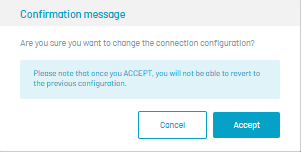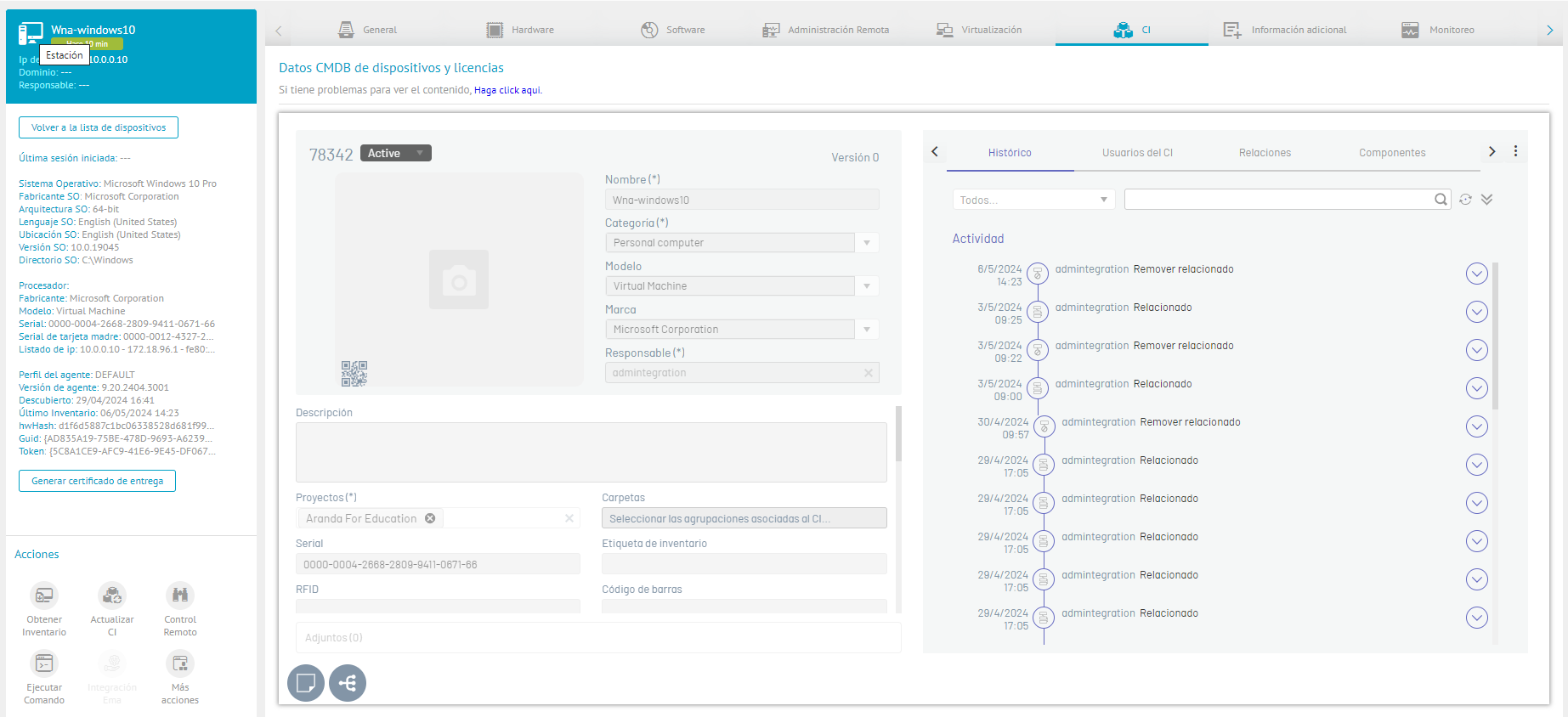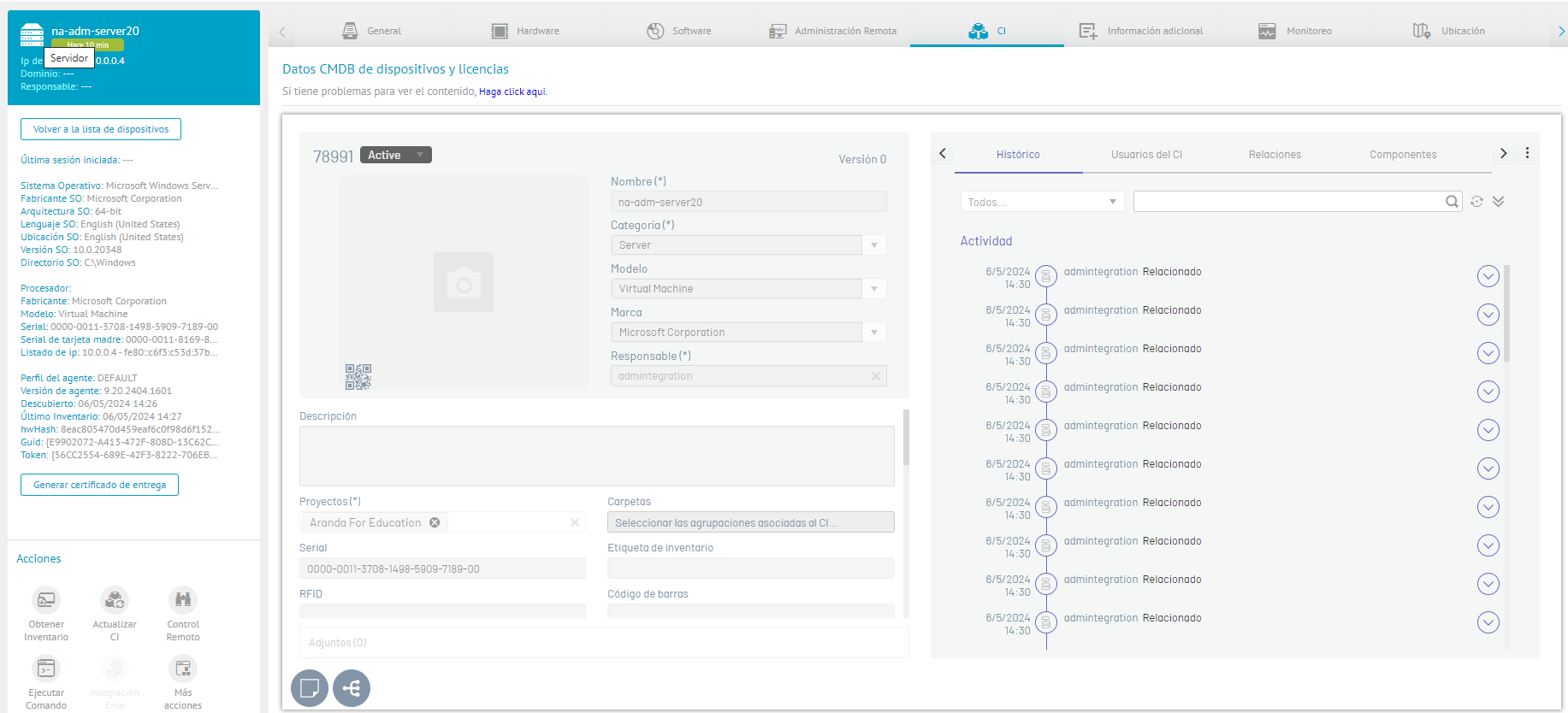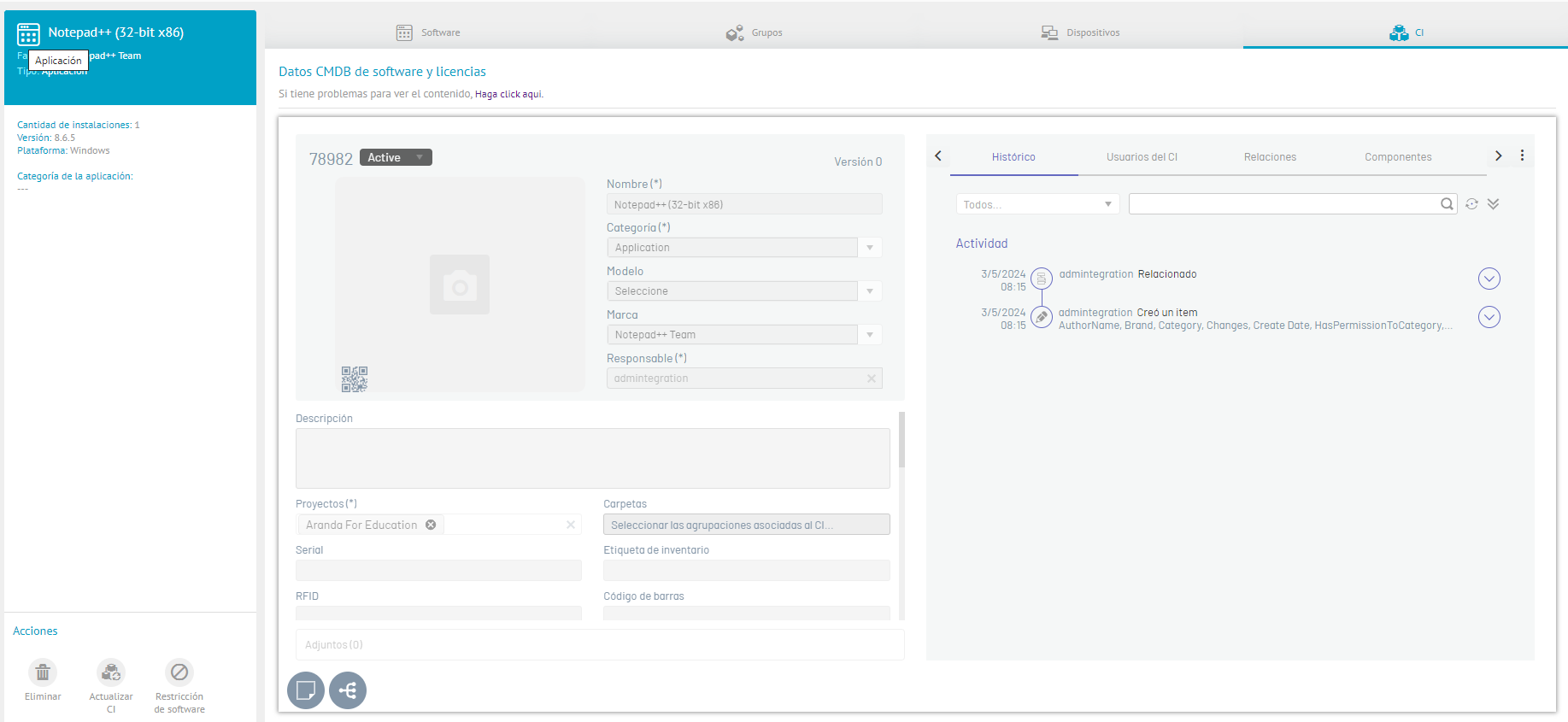In the new common data model, native IC categories are implemented from CMDB9, which are associated with ADM assets and are aligned with ITSM industry standards. These native categories are automatically synchronized to the CMDB and without the need for user intervention, in addition to the initial configuration of the connection itself to the CMDB.
ADVANTAGES: - Automatic creation of CIs in the CMDB.
- Automatic creation of relationships between CIs in the CMDB
- Automatic modification/deletion of relationships between CIs in CMDB based on ADM events.
- Ability to add new ICs via discovery (coming soon)
Configuring the Connection with CMDB V9.8.0
To configure or modify the integration with Aranda V9, go to the configuration view of the ADM Management Console, in the General from the main menu, select the Enterprise Integration and the CMDB. In the information view, enable the version of CMDB corresponding to the Version 9.8.0.

To configure version 9.8.0, follow these steps:
1. Go to the Connecting to CMDB after the Version 9.8.0 Then, click New Connection. A confirmation message will appear stating that you will not be able to return to the previous settings. Select OK to continue

2. Fill in the requested data: URL of the Service and Token (see Token configuration)

3.Click Verify Connection. If the connection is successful, the button will change color to green, indicating that the information entered is correct and that the configuration is confirmed. In case the connection is not successful, the button will remain orange, indicating that it is necessary to verify the data again.
⚐ Note: Once this new model is selected, you will not be able to return to the previous model.
Clean Connection
1. To remove the connection, click the Clean Connection. A confirmation message will be displayed to proceed with the action.

⚐ Note: Confirming the request will delete all information and display a transaction confirmation message.
- Cleaning the connection will erase all information related to the CMDB, including previously synced CIs. Therefore, if you perform a new integration with the same CMDB, you may duplicate the CIs. Also, the previous settings will be lost.
Edit Settings
1. This will allow you to modify the settings. Click the pencil icon and adjust the corresponding values.
Delete settings
1. This will delete the settings. To continue, click on the draft icon.
⚐ Note: Confirming the request will delete all stored information and display a confirmation message for the transaction.
-Deleting the connection will delete the information related to the CMDB, including any CIs that have been previously synchronized. This can lead to duplicates if a new integration is made with the same CMDB, in addition to losing the previous configuration.
- If the connection data of the CMDB server is modified, all related information will also be deleted, including the synchronized CIs.
This section will explain the relationship between CMDB9 native CIs and their visualization as ADM assets.
Categories of IC’s
The categories of configuration items (CIs) “native” from CMDB9, associated with ADM assets are:
| Asset Type (ADM) | Origin (ADM) | CI Category (CMDB) |
|---|---|---|
| Application | Applications installed on each of the workstations, notebooks and servers inventoried. E.g. “Word 2013” | Application |
| Workstation | Workstation inventoried in ADM. e.g. “BG-D-ACANON01” | Personal Computer |
| Portable | Laptop inventoried in ADM. e.g. BG-P-ACANON01 | Personal Computer |
| Printer | Printer detected in the discovery process via SNMP protocol | Printer |
| Router | Router detected in the discovery process via SNMP protocol | Router |
| Switch | Switch detected in the discovery process over SNMP protocol | Switch |
| Server | Physical server inventoried in ADM. E.g. “SRVAPP01” | Server |
| Operating system | Operating system installed on each of the workstations, notebooks and servers inventoried. E.g. “Windows 2012 Server” | Operating system |
| User | Responsible or frequently used user of an asset inventoried in ADM. | User |
Configuring Native Categories in CMDB
Types of relationships
Based on the categories of native ICs, the following types of native relationships are established
| Category CI 1 (Father) | Category CI 2 (Child) | Direct Relationship Name (1 -> 2) | Name direct relationship (2-> 1) |
|---|---|---|---|
| Application | Personal Computer | It runs in | Runs |
| Application | Server | It runs in | Runs |
| Personal Computer | Operating system | Used | Installed in |
| Personal Computer | User | Responsibility of | Responsible for |
| Server | Operating system | Used | Installed in |
| Server | User | Responsibility for | Responsible for |
Configuring Native Relationship Types in CMDB
CI synchronization with ADM assets
The CI’s are automatically synchronized after the correct configuration of the new CMDB9 model through the generation of the Hardware and Software inventory, the following table exposes the information that is displayed in ADM for each asset.
Native CIs for category types
| Asset Type (ADM) | Category CI (CMDB) | Native CIs for category types | Additional information |
|---|---|---|---|
| 1. Workstation | Personal Computer | Name CI •Brand •Model •Serial |
Is Laptop False |
| 2. Portable | Personal Computer | Name CI •Brand •Model •Serial |
Is Laptop True |
| 3. Server | Server | Name CI •Brand •Model •Serial |
N/A |
| 4. Application | Application | Name CI •Brand: Manufacturer Information •Model: NULL |
N/A |
| 5. Operating System | Operating system | Name CI •Brand: Manufacturer Information •Model: NULL |
N/A |
| 6. Responsible | User | Is associated as responsible of the asset in cmdb (Personal Computer or server) |
N/A |
 1. Workstation
1. Workstation
Information corresponding to the Native categories of the new Common Data Model (MSCD) CMDB is displayed. If the ADM and CMDB websites are not on the same domain or you have problems viewing all the IC information, select the “Click here” option, a new tab will open in the browser with the CI information.

The responsible user is displayed in the CMDB relationship when it is assigned (See Responsible User Assignment) and the device CI is updated from the ADM console.
 2. Portable
2. Portable
Information corresponding to the Native categories of the new Common Data Model (MSCD) CMDB is displayed. If the ADM and CMDB websites are not on the same domain or you have problems viewing all the IC information, select the “Click here” option, a new tab will open in the browser with the CI information.

The responsible user is displayed in the CMDB relationship when it is assigned (See Responsible User Assignment) and the device CI is updated from the ADM console.
 3. Server
3. Server
Information corresponding to the Native categories of the new Common Data Model (MSCD) CMDB is displayed. If the ADM and CMDB websites are not on the same domain or you have problems viewing all the IC information, select the “Click here” option, a new tab will open in the browser with the CI information.

The responsible user is displayed in the CMDB relationship when it is assigned (See Responsible User Assignment) and the device CI is updated from the ADM console.
 4. Application
4. Application
Information corresponding to the Native categories of the new Common Data Model (MSCD) CMDB is displayed, for each application installed on the device. If the ADM and CMDB websites are not on the same domain or you have problems viewing all the IC information, select the “Click here” option, a new tab will open in the browser with the CI information.

 5. Operating System
5. Operating System
Information corresponding to the Native categories of the new Common Data Model (MSCD) CMDB is displayed, by operating system product installed on the device. If the ADM and CMDB websites are not on the same domain or you have problems viewing all the IC information, select the “Click here” option, a new tab will open in the browser with the CI information.

Automatic CI Relationship Creation and Deletion
The respective relationships are created between the CIs synchronized from ADM to CMDB, according to the native relationship types defined above. These relationships are created later after synchronizing the information of the CIs (in the processing of the Hardware and Software inventory).
The Printer, Router, and Switch ICs are synchronized in the SNMP discovery process after 10 minutes.
The elimination of the relationship between the ICs is carried out from changes in the respective assets in ADM that do not imply the elimination of the asset and that modify any indicative attribute of a relationship with another asset, the current relationship between the CIs is eliminated and a new one is created. View relationship information in CMDB
Disable New Common Data Model (DCM) - CMDB9
If you need to disable synchronization with the Common Data Model (DCM) - CMDB9.
1. Run the following script:
INSERT INTO afw_settings
([sett_key]
,[sett_application_id]
,[sett_value]
,[sett_description]
,[sett_project_id])
VALUES
('Disable_CMDB_Sync'
,1
,'true'
,'Activa o inactiva la sincronización con CMDB'
,null)
2. If you want to turn sync back on, you need to change the sett_value field to False
⚐ Note: Disabling and then enabling sync loses data that was pending sync during the period that sync was disabled.


